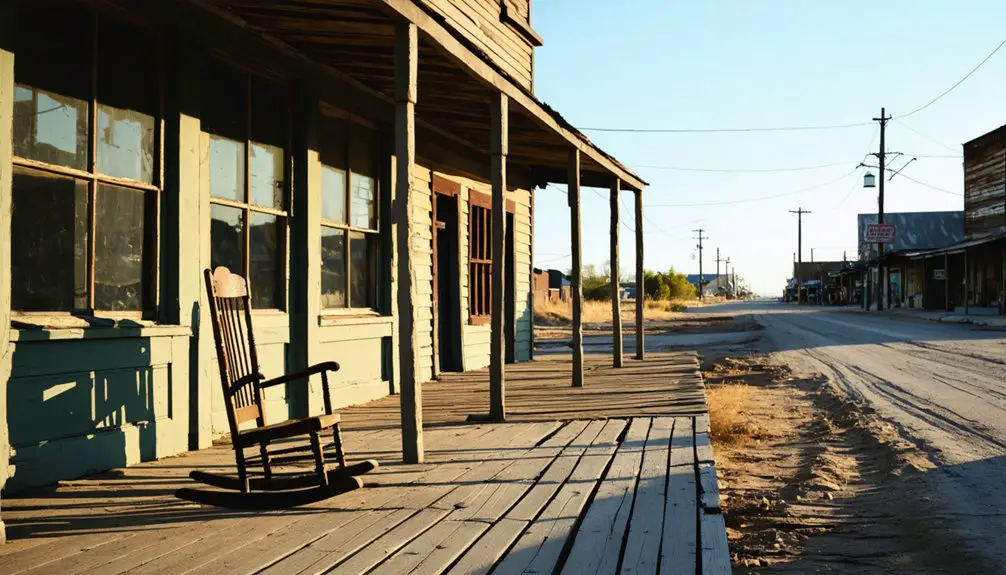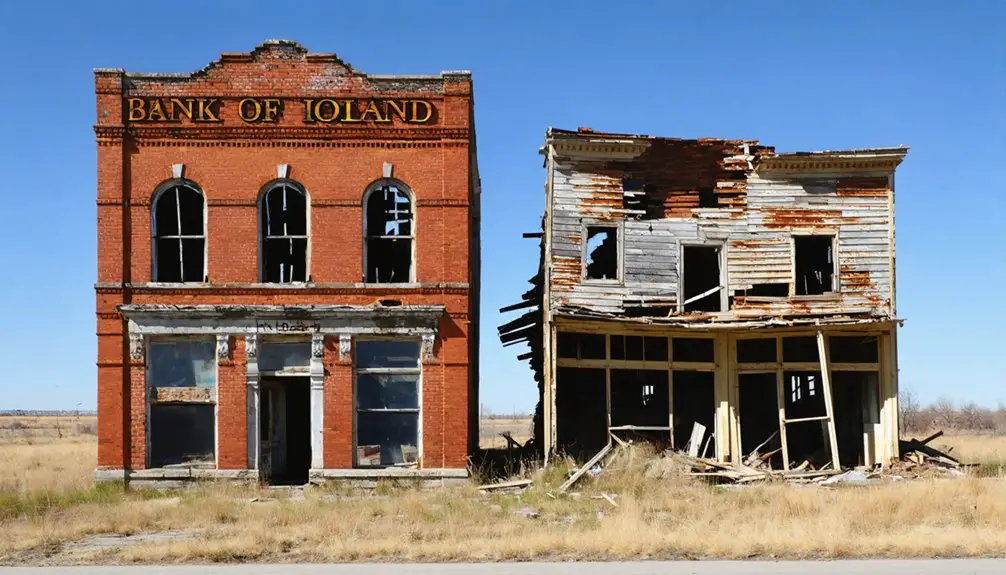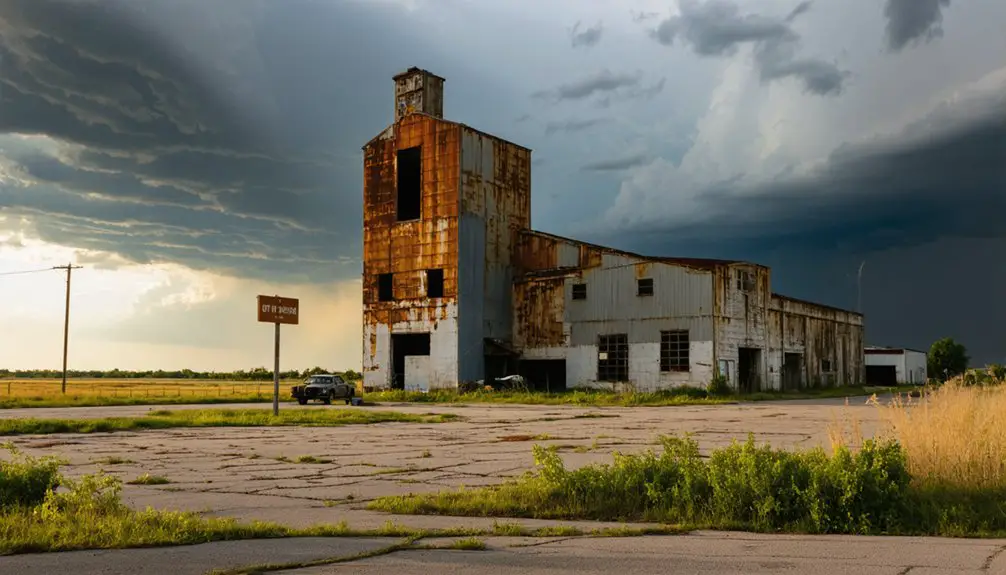You’ll find Ioland on the north bank of Oklahoma’s Canadian River, where it briefly served as Day County’s seat from 1890 to 1893. Named after courthouse contractor Charles Day, this territorial town emerged as a small but essential administrative center with a courthouse, general stores, and post office. When fire destroyed the courthouse in 1893, the county seat moved to Grand, leaving Ioland to fade into the frontier’s forgotten chapters.
Key Takeaways
- Ioland served as Day County’s temporary seat from 1890-1893 before becoming a ghost town after its courthouse burned down.
- The settlement was located on the Canadian River’s north bank in east-central Day County, Oklahoma Territory.
- Economic activities centered around farming and small-town commerce, with general stores and a post office serving local needs.
- Poor location, inadequate facilities, and territorial governance conflicts contributed to the town’s eventual abandonment.
- After the courthouse fire in 1893, the county seat moved to Grand, leading to Ioland’s rapid decline into ghost town status.
The Rise and Fall of a Territorial Town
When Oklahoma Territory was established in 1890, Ioland emerged as the temporary county seat of Day County, marking a brief but significant chapter in the region’s early administrative history.
You’ll find that this frontier town, named after courthouse contractor Charles Day, represented the ambitious hopes of early territorial development despite its challenging location near the Canadian River. The region’s development mirrored other areas like South Dakota’s Day County, which was established in 1880 under similar frontier conditions. The Iowa Indian tribe, who had been assigned land south of the Cimarron River in 1883, maintained their presence in the surrounding territory.
Ioland’s territorial history was marked by mounting difficulties. You couldn’t ignore the poor water quality that plagued residents, while the town’s inconvenient location frustrated county citizens, especially those north of the river.
When the courthouse mysteriously burned down in November 1893, it sealed Ioland’s fate. The county seat shifted to Grand, and Ioland’s importance diminished, highlighting the harsh realities of territorial conflicts and settlement challenges.
Life Along the Canadian River
Along the meandering Canadian River, you’ll discover a diverse landscape that shaped centuries of human settlement and activity.
French explorers initially called it the Canadian River, mistakenly thinking it flowed northward into Canada.
The river’s ecology supported abundant wildlife and fertile bottomlands where indigenous agriculture flourished, with tribes like the Caddo, Cherokee, and Creek cultivating maize and squash.
You’ll find evidence of diverse terrains, from semi-deserts to forests, that influenced how people lived and traveled. The Cheyenne and Arapaho established their presence in 1867 through the Treaty of Medicine Lodge, adding to the rich tapestry of Native American life along the river.
Early Days as Day County’s Seat

You’ll find Ioland’s brief tenure as Day County’s first seat of government began in 1890, when it was designated the temporary county seat of what was then called County E.
The settlement, positioned along the north bank of the Canadian River in east-central Oklahoma Territory, served as the administrative center where Charles Day constructed the county’s first courthouse.
The courthouse’s presence established Ioland as the hub of territorial operations until 1893, though the town’s poor location relative to the county’s population would ultimately prove problematic. Like much of Day County’s tumultuous history, the courthouse faced its own dramatic end when it was destroyed in a courthouse burned incident.
Territorial Government Operations
After Oklahoma Territory’s establishment in 1890, Ioland served as the seat of Day County during a period of complex territorial governance.
You’d have seen the challenges of early administration firsthand, as officials worked without permanent facilities, operating from rented spaces while dealing with territorial governance challenges.
The system you’d encounter would’ve included federally appointed governors and judges overseeing local matters, with legislative authority limits defined by the Organic Act.
Like other county seats, Ioland operated under Nebraska’s laws until Oklahoma Territory developed its own statutes.
You’d have witnessed the growing pains of a new territory, where disputes over land claims and settler conflicts kept law enforcement busy, and where provisional governments struggled to maintain order during rapid development.
The territory was initially divided into six counties, with administrative responsibilities distributed across these jurisdictions including Day County where Ioland was located.
The territorial capital of Guthrie served as the central hub for government operations and policy-making.
Location and County Functions
Ioland stood prominently on the north bank of the Canadian River in east-central Day County, serving as the temporary county seat from 1890 to 1893.
You’ll find its location at roughly 35.9439°N latitude and 99.5218°W longitude, in what was originally designated as County E before becoming Day County. The town’s geography proved challenging for county governance, as most residents lived south of the Canadian River, making access difficult.
The settlement’s role as county seat ended abruptly when the courthouse burned down on November 12, 1893. County operations then moved to Grand, Oklahoma, which offered a more central location for the population.
Today, all that remains of Ioland‘s brief but significant administrative period is the cemetery, now situated in Ellis County following Oklahoma’s statehood in 1907.
A Frontier Justice Tragedy
While the establishment of formal law enforcement struggled to take root in Indian Territory, a dark chapter in frontier justice unfolded in the small settlement of Ioland during the 1890s.
In an environment of frontier lawlessness, J.L. Chandler became Oklahoma Territory’s first lynching victim after locals accused him of poisoning the town’s water supply. You’ll find this tragic incident reflected the era’s volatile mix of inadequate law enforcement and quick-trigger vigilante justice. Like many rural areas of the 1920s, citizens took on investigative duties themselves, leading to compromised evidence and flawed conclusions.
The case exemplified the period’s flawed approach to justice, where all-white citizen inquests conducted amateur investigations tainted by prejudice and fear.
Without developed police structures or proper forensic methods, frontier communities often bypassed legal protections in favor of swift, brutal retribution that served as a stark warning to others. The region’s instability was further intensified by the influx of white settlers who disregarded federal laws protecting Indian Territory.
Daily Life in Early Ioland

You’d find the daily rhythms of early Ioland centered around both farming tasks and small-town commerce, with settlers balancing their agricultural duties against trips to the general store and blacksmith shop near the Santa Fe Railway tracks.
Your success in this frontier community depended heavily on participating in local trade networks, where farm produce could be bartered for manufactured goods and essential services. Many settlers faced poor land quality that made sustaining successful farming operations particularly challenging.
If you ran into legal troubles, you’d have to rely on the informal territorial justice system, which operated through a combination of local peacekeepers and community-based conflict resolution before formal courts were established.
Pioneer Community Routines
Life in early Ioland revolved around the demanding routines of pioneer survival, with settlers establishing their homesteads in simple log cabins or sod houses.
You’d find yourself rising before dawn to tend livestock, fetch water from wells, and prepare meals on wood-fired stoves. Daily chores consumed most of your time – from mending clothes to preserving food for winter.
Community gatherings at the local church or town hall became essential lifelines, where you’d strengthen bonds with neighbors through shared experiences.
You’d participate in labor exchange, helping fellow settlers with barn-raising or harvest, knowing they’d return the favor.
Children attended school when available, while adults coordinated important tasks through face-to-face meetings and bulletin board notices.
These social connections proved critical for surviving the harsh realities of pioneer life in Ioland.
Local Trade and Commerce
As the frontier settlement of Ioland grew, small retail stores and general mercantiles emerged as essential commercial hubs where you’d find vital supplies for pioneer living. You could purchase food staples, farming tools, clothing, and household necessities, or barter with local goods from nearby mines and farms.
These establishments weren’t just places of commerce – they served as community gathering spots where you’d exchange news and socialize with neighbors.
The success of Ioland’s trade networks heavily depended on transportation access. If you were lucky enough to be near a railroad or stagecoach route, you’d have access to a wider variety of imported goods.
Without such connections, you’d face higher prices and limited product selection, often relying on traveling merchants to bring supplies from larger towns.
Territorial Justice System
When Oklahoma remained a territory in the 1890s, Ioland residents navigated a complex web of overlapping legal jurisdictions. You’d find yourself answering to territorial courts that served dual roles as both federal and territorial authorities, handling everything from bootlegging cases to land disputes.
The judicial authority stretched across multiple court divisions, with cases heard based on where the offense occurred.
- Territorial courts couldn’t empanel grand juries for certain offenses
- Tribal courts maintained authority on tribal lands
- Local sheriffs worked alongside tribal police through cross-deputization
- The Muscogee Lighthorse Police patrolled nearby areas
If you lived in Ioland, you’d need to understand whether your case fell under tribal, federal, or territorial jurisdiction – a distinction that often depended on your identity and where the incident took place.
The Town’s Essential Buildings

The essential buildings of Ioland reflected the typical infrastructure of early Oklahoma settlements, with civic, commercial, and residential structures arranged around a central business district.
You’d have found the town’s community hubs concentrated near Main Street, where the post office served as a crucial communication center and the town hall managed local affairs.
Essential structures included a general store supplying residents with hardware and groceries, while scattered residential zones featured family homes and duplexes.
Churches anchored the spiritual life of Ioland’s citizens, often serving as social gathering spots alongside their religious functions.
The railroad depot facilitated goods transport and passenger travel, while service stations later emerged to support automobile traffic, marking Ioland’s evolution through Oklahoma’s territorial and early statehood periods.
Administrative Power Shift
During Oklahoma’s territorial period, Ioland’s fortunes rose and fell with its administrative authority as the seat of Day County, established by Congress in March 1891.
You’ll find that the town’s administrative decline began in November 1893 when the county seat transferred to Grand, stripping Ioland of its governmental prominence.
As Ioland faced governance challenges, you’d witness these critical changes:
- Loss of courthouse operations and legal proceedings
- Migration of businesses and residents toward Grand
- Deterioration of local infrastructure and services
- Diminished political influence in territorial affairs
The town’s struggle with maintaining order became evident through events like the lynching of J.L. Chandler, the first such incident in Oklahoma Territory.
When Day County dissolved upon Oklahoma’s statehood in 1907, Ioland’s administrative significance vanished completely, sealing its fate as a ghost town.
Legacy in Ellis County

Following Day County’s dissolution in 1907, Ioland’s legacy became permanently intertwined with the newly formed Ellis County, where northern portions of the former territory merged under a fresh administrative structure.
You’ll find Ioland’s influence reflected in Ellis County’s diverse cultural influences, particularly through the German-Russian settlements that emerged near Shattuck in the early 1900s.
The town’s history as Day County’s original seat shaped subsequent settlement patterns throughout Ellis County, even as Arnett claimed the new county seat position.
While Ioland itself faded into ghost town status, its historical imprint endures through cemetery markers and documented accounts of significant events, including a notorious lynching that impacted local governance.
The area’s agricultural heritage and ranching traditions continue to echo the economic foundations established during Ioland’s brief period of prominence.
What Remains Today
Modern visitors to Ioland’s former townsite will find just two tangible remnants of this once-prominent Day County seat: the historic Ioland Cemetery and weathered Ioland School structure.
These historical artifacts stand as silent witnesses to the community’s significance in Ellis County’s past, situated near the Canadian River at coordinates 35.9439°N, 99.5218°W.
You’ll discover a landscape now reclaimed by nature, where the town’s physical traces have largely vanished into southeastern Ellis County’s rural terrain.
Beyond these two landmarks, Ioland’s legacy exists primarily in historical records rather than physical form.
- No commercial buildings or residential structures remain standing
- Natural elements have overtaken the former townsite
- No tourism infrastructure or interpretive facilities exist
- The cemetery serves as the primary historical marker for the community
Historical Significance in Oklahoma Territory
Ioland’s brief tenure as Day County’s seat of government in Oklahoma Territory showcases how political power could rapidly shift during the region’s formative years.
You’ll find the town’s darkest chapter in the Territory’s first recorded lynching of J.L. Chandler, accused of poisoning the local water supply, which exemplifies the stark realities of frontier justice.
The town’s eventual decline mirrors broader administrative changes in the Territory, where county reorganizations and seat relocations often determined whether settlements would thrive or fade into obscurity.
County Seat Political Power
When Oklahoma Territory was organized in 1890, the designation of county seats became a pivotal source of political power and regional influence. In the case of Ioland, you’ll find a classic example of county seat dynamics at work.
As the temporary seat of County E (later Day County), Ioland’s political influence was undermined by practical challenges that revealed deeper power struggles between competing interests.
- Control of the county seat meant authority over taxation and legal matters
- Local governance and resource distribution hinged on seat location
- Political tensions arose between small farmers and cattle ranchers
- Settlement patterns and population distribution drove power shifts
The mysterious burning of Ioland’s courthouse in 1893 ultimately led to the seat’s relocation to Grand, reflecting how political influence could shift based on changing territorial demographics and regional interests.
Frontier Justice and Lynching
Beyond the political power struggles over county seats, a darker aspect of Oklahoma Territory’s history emerged through its system of frontier justice and lynching.
You’ll find that from 1885 to 1907, lynching dynamics shifted dramatically across racial lines, with 106 documented cases targeting whites, Blacks, American Indians, and one Chinese individual. The Territory’s weak law enforcement led to widespread vigilante justice, especially in rural areas where mobs carried out extrajudicial punishments for alleged crimes.
After statehood in 1907, the pattern changed considerably – 79% of lynchings targeted Black Oklahomans, revealing how frontier justice evolved from general criminal punishment into a tool of racial terror.
This system of extralegal violence reached its tragic peak during events like the 1921 Tulsa Race Massacre.
Administrative Geography Changes
The administrative geography of Oklahoma Territory underwent dramatic shifts during the 1890s, as exemplified by Ioland’s changing status within the now-defunct Day County.
You’ll find that territorial governance evolved rapidly as Oklahoma approached statehood in 1907, with county reorganizations reshaping the political landscape. Ioland’s brief tenure as Day County’s seat ended in November 1893, marking a turning point in the town’s destiny.
- Day County’s dissolution split its lands among neighboring counties
- Ioland shifted from county seat to Ellis County territory
- Administrative changes mirrored population shifts and development needs
- County boundary adjustments impacted local governance and economies
These geographic transformations weren’t merely lines on a map – they determined the fate of frontier communities like Ioland, illustrating how administrative decisions could make or break territorial settlements.
Frequently Asked Questions
What Native American Tribes Originally Inhabited the Area Around Ioland?
You’ll find the Osage, Quapaw, and Wichita tribes dominated the tribal history around this area, with their cultural influences evident through hunting grounds, while Comanche, Kiowa, and Apache groups passed through seasonally.
How Did Early Settlers Travel to Reach Ioland Before Established Transportation Routes?
You’d reach Ioland primarily on horseback or using horse drawn wagons, following early trails marked by natural landmarks across open plains, while managing harsh weather and limited water sources.
What Was the Town’s Population at Its Peak?
While exact records aren’t available, you’re looking at population growth similar to nearby mining towns, which peaked between 500-2,000 residents during the 1920s before demographic changes led to decline.
Were There Any Notable Natural Disasters That Affected Ioland?
You won’t find records of specific tornado impacts or flood damage affecting Ioland, though its location by the Canadian River posed flood risks typical of river-adjacent Oklahoma towns.
What Happened to the Original Courthouse Records After Ioland Lost Prominence?
You’ll never know with certainty – the courthouse records’ historical significance was likely compromised when they were either destroyed by fire, lost during transfer, or scattered between McCurtain County and Oklahoma archives.
References
- https://en.wikipedia.org/wiki/List_of_ghost_towns_in_Oklahoma
- https://en.wikipedia.org/wiki/Ioland
- https://www.youtube.com/watch?v=5d-wHDTIbb0
- https://www.okhistory.org/publications/enc/entry?entry=GH002
- https://savingplaces.org/guides/ghost-towns-on-route-66
- https://en.wikipedia.org/wiki/Day_County
- http://www.okterritory.org/history.html
- https://theactivehistorian.com/2022/05/01/oklahoma-territorial-museum-guthrie-ok/
- https://www.youtube.com/watch?v=jcbyntLCj2U
- https://okgenweb.net/~okcanad/



